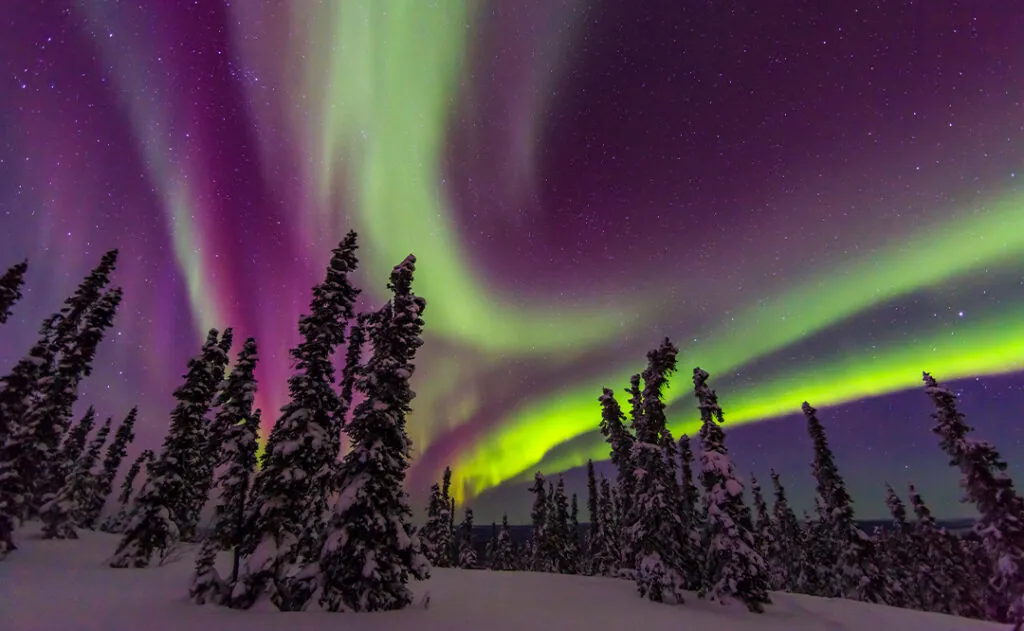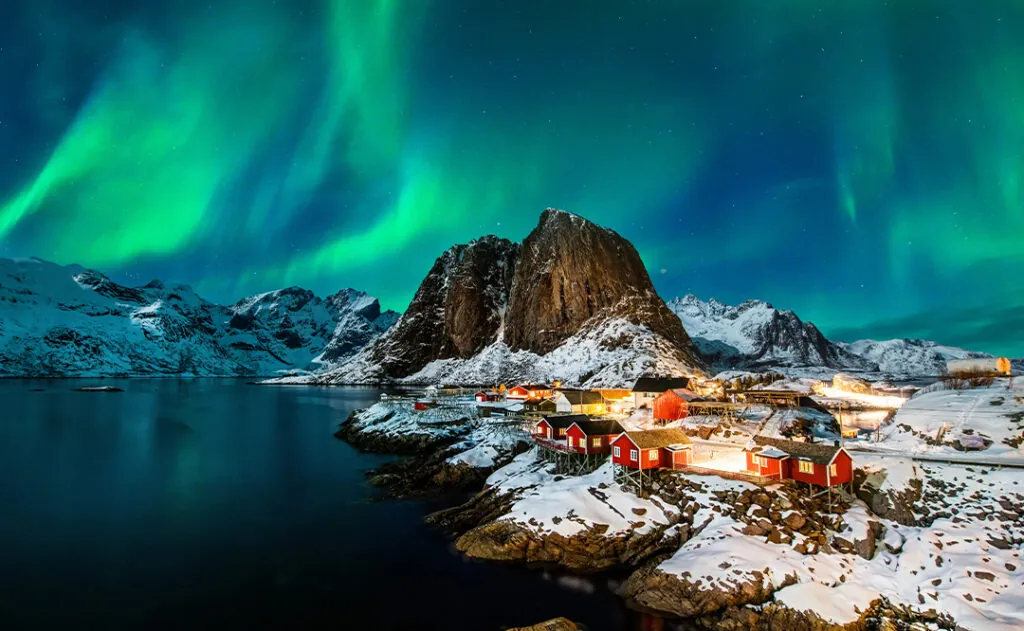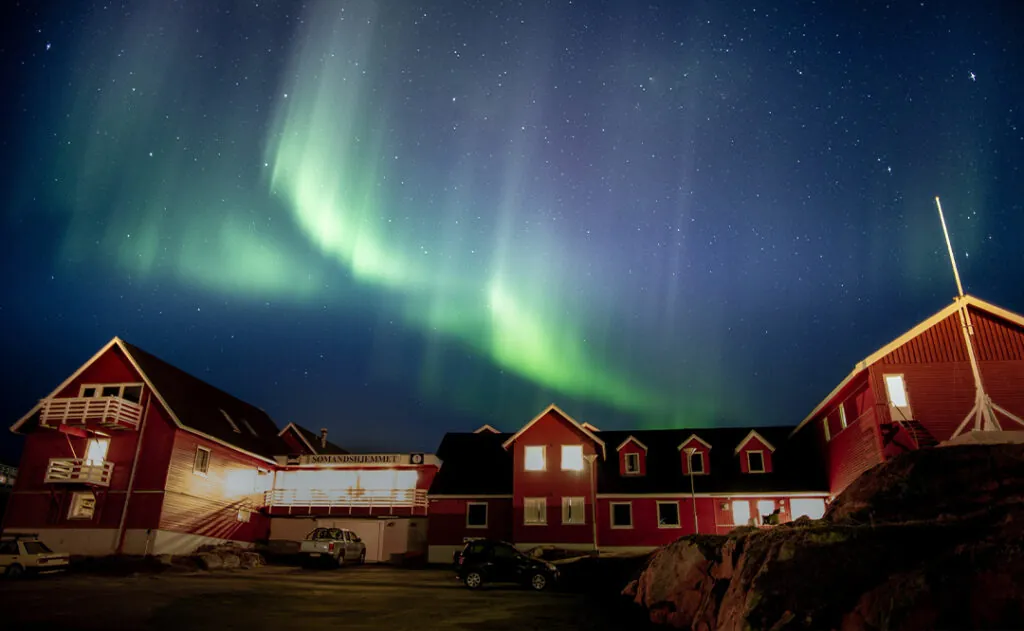Seeing the sky light up with vibrant, swirling hues of blue, green, and even pink is an unforgettable experience. This naturally occurring phenomenon is known as the Aurora Borealis or northern lights (because it’s only visible at northern latitudes). This year is forecasted to be one of the most active times for the solar cycle—so book that bucket list northern lights trip now.

What are the Northern Lights?
The northern lights are caused by energized particles from the sun entering the Earth’s upper atmosphere at high speeds. The National Aeronautics and Space Administration (NASA) offers a more scientific explanation of the northern lights, saying, “When a solar storm comes toward us, some of the energy and small particles can travel down the magnetic field lines at the north and south poles into Earth’s atmosphere. There, the particles interact with gases in our atmosphere resulting in beautiful displays of light in the sky. Oxygen gives off green and red light.”
The Best Places to See the Northern Lights
The best places to see the northern lights are northern destinations with minimal light pollution, clear skies, and dry weather.
Iceland

You don’t have to venture too far outside the brightly-lit downtown area of Iceland’s capital city, Reykjavik, to see the northern lights. Within the city itself, you’ll find Perlan, a famous Icelandic observatory rising 61 meters above Reykjavik. The glass-domed top structure offers a warm indoor spot to wait for the light show.
If you weren’t lucky enough to spot the Aurora at Perlan, the planetarium has an immersive northern lights video show that’s the next best thing.
Alaska

Alaska is by far the best place in the United States to see the northern lights. Although the northern lights can be seen statewide, the best places to see them in Alaska are the Interior, Arctic, and Southcentral regions due to their locations under the auroral oval.
If you’re based in Fairbanks, we recommend booking a northern lights guided tour, which will take you away from city lights. These tour operators monitor weather conditions and aurora forecasts and take groups to spots where there’s the best chance to see the lights. Choose one of the tours that allow you to book a multi-day window instead of a specific date—that way, you’re not locked into a tour on a night that ends up being rainy or cloudy.
Canada

If you want to see the northern lights in summer, you can actually view them during all four seasons in Canada (but you’ll have the best luck from December to March). Destination Canada recommends the Northwest Territories as the best place in Canada to see the northern lights. In the Northwest Territories, the aurora is visible on an average of 240 nights per year.
Hoping to spot the lights in the Edmonton area? Sign up for this free email alert that will let you know if there might be an aurora that night.
The Faroe Islands

Some of the most spectacular auroras in the world can be spotted on the Faroe Islands. These far-flung islands, located between Iceland and Norway, are difficult to reach, but their remote location helps with the northern lights viewing, thanks to minimal light pollution.
The peak season for aurora viewing on the Faroe Islands runs from late October to early March.
Sweden

You can see the northern lights from anywhere in Sweden, but for the most brilliant auroras, go north to Swedish Lapland. This isolated swatch of land offers pitch-dark nights and crisp conditions that are optimal for the lights.
The best time to see the northern lights in Sweden is between 6 pm and 2 am, and the colors are generally most vivid between 10 and 11 pm.
Norway

Statistically, the best time to see the northern lights in Norway is during March, April, September, or October. Visitors in the winter months will also have a good chance of seeing some aurora activity.
One of the best methods for hunting the northern lights is by boat, as you’re away from land (and light pollution). In Norway, plenty of companies offer overnight northern light cruises that cross the Arctic Circle, guaranteeing stunning scenery during the day (even if the aurora spotting is not guaranteed).
Greenland

Want to see the northern lights on your summer vacation? Head to Greenland, where the Aurora Borealis can be seen as early as the end of August. (However, late September is when the northern light season really kicks off.)
Greenland’s position as the northernmost country, along with minimal light pollution and hundreds of clear sky days each year, make it one of the best places in the world to see the northern lights.
Scotland

If you’re hoping to see the northern lights in the United Kingdom, it makes sense to head north to Scotland. Northern Scotland lies at the same latitude as parts of Norway and Alaska, making it one of the best spots to see the lights.
For a magical experience and the best chance to witness the ‘Mirrie Dancer’ as the northern lights are nicknamed in Scotland, go to the Trotternish Peninsula on Skye, which is home to nine Dark Sky Discovery Sites.
The Best Time to See the Northern Lights
Since the northern lights can only be seen after dark, September through April are the best times to see them. The northern lights occur year-round but are not visible to the human eye when the sun is out—In many northern destinations, the days are too long in the summer to create dark enough conditions to see the phenomenon.
The best time of night to see the northern lights varies by destination but is generally between 10 pm and 2 am.
Northern Lights Tracker
Find out where you’ll have the best chance of seeing the northern lights by using a northern lights tracker like this one from the National Oceanic And Atmospheric Administration (NOAA). The tracker shows a short-term forecast for auroras around the world.
5 Tips for Seeing the Northern Lights
- Find a viewing spot with an unobstructed view toward the north
- Time your trip for when the moon is least visible (a full moon will diminish your ability to see the northern lights)
- Avoid light pollution
- Plan a multi-night trip so you have better odds of seeing an aurora
- Ask your hotel reception to call your room and wake you up if the northern lights occur
You Might Also Like:
• No Signal? 5 Ways to Use Your Phone GPS Without Data• The 10 Most Dangerous National Parks in America
• The Thinnest, Warmest Winter Clothes for Packing
• The 15 Most Scenic Amtrak Routes in North America
• 10 Warm, Lightweight Jackets and Coats for Travelers
We hand-pick everything we recommend and select items through testing and reviews. Some products are sent to us free of charge with no incentive to offer a favorable review. We offer our unbiased opinions and do not accept compensation to review products. All items are in stock and prices are accurate at the time of publication. If you buy something through our links, we may earn a commission.
Related
Top Fares From
Today's Top Travel Deals
Brought to you by ShermansTravel
Italy: 8-Night Rome, Florence & Venice...
Infinity Worldwide Vacations
 vacation
$2335+
vacation
$2335+
Athens to Venice: 9-Night Cruise w/Choice...
Windstar Cruises
 cruise
$3999+
cruise
$3999+
Ohio: Daily Car Rentals from Cincinnati
85OFF.com
 Car Rental
$19+
Car Rental
$19+




